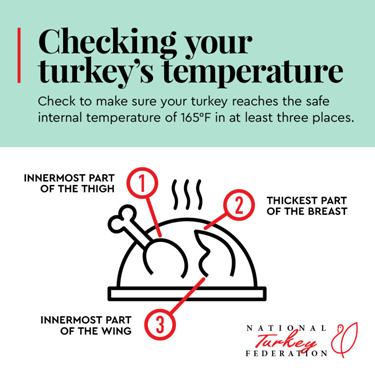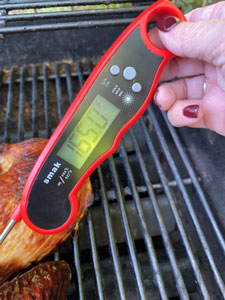The art of cooking a delicious and safe turkey lies in mastering the use of a meat thermometer. This essential tool provides accurate temperature readings, guiding you towards a perfectly cooked bird that’s both juicy and free from harmful bacteria. Let’s delve into the intricacies of using a meat thermometer on your turkey, ensuring a Thanksgiving feast that’s both memorable and worry-free.
Choosing the Right Thermometer:
- Instant-read thermometers: These digital marvels provide rapid temperature readings, ideal for checking the internal temperature of your turkey throughout the cooking process.
- Leave-in thermometers: These thermometers remain inserted in the turkey during cooking, offering continuous temperature monitoring. Some models even come with alarms that alert you when the desired temperature is reached.
Where to Place the Thermometer:
- Thigh: Insert the thermometer into the thickest part of the thigh, avoiding contact with the bone. Aim for a depth of 2-3 inches.
- Wing: Similar to the thigh, insert the thermometer into the thickest part of the wing, avoiding the bone.
- Breast: The breast is the most crucial area to check, as it’s the densest part of the turkey and takes the longest to cook. Insert the thermometer into the thickest part of the breast, ensuring it’s not touching the bone or cavity.
Reading the Temperature:
- Safe internal temperature: The USDA recommends a safe internal temperature of 165°F for all parts of the turkey, including the thigh, wing, and breast.
- Resting period: Remember that the turkey’s temperature will continue to rise by about 5-10°F during the resting period after it’s removed from the oven.
Additional Tips:
- Calibrate your thermometer: Ensure accuracy by calibrating your thermometer before each use. You can do this by immersing the tip in ice water; it should read 32°F.
- Multiple readings: Take temperature readings from different locations in the turkey to ensure even cooking.
- Don’t touch the bone: Avoid contact with bones, as they conduct heat differently than meat and can give inaccurate readings.
- Clean your thermometer: Wash your thermometer thoroughly with hot, soapy water after each use.
Beyond the Basics:
- Oven temperature: Double-check your oven’s temperature using an oven thermometer to ensure accurate cooking.
- Resting time: Allow the turkey to rest for at least 20 minutes before carving. This allows the juices to redistribute, resulting in a more tender and flavorful bird.
Using a meat thermometer is an indispensable tool for achieving a perfectly cooked turkey. By following these guidelines, you can ensure a safe and delicious Thanksgiving feast that will leave your guests wanting more. Remember, a little effort with the thermometer goes a long way in guaranteeing a memorable and stress-free holiday meal.
Keywords: meat thermometer, turkey, Thanksgiving, safe internal temperature, thigh, wing, breast, calibration, resting period, oven temperature, accurate cooking, delicious, juicy, safe, memorable, stress-free
Where to Put the Thermometer in a Turkey

Placing the thermometer correctly inside the turkey is crucial when using any type of thermometer. Here are some pointers to bear in mind if you’re not sure where to insert the thermometer in a turkey:
- Place the thermometer into the thickest part of the turkey breast, the innermost part of the thigh, and the innermost part of the wing when cooking an entire turkey.
- Ensure that the thermometer stays away from the pan, bone, or gristle.
- The thermometer should be inserted from the side into a ground turkey patty or turkey breast. Compared to when it is inserted from the top, the thermometer is more accurate and easier to read.
Your turkey (as well as any stuffing) should always be cooked to an internal temperature of 165°F.

According to the U. S. Food and Drug Administration reports that from 49% in 1998 to 70% in 2010, more consumers now own food thermometers. Utilizing a meat thermometer is advised by the USDA and the National Turkey Federation to guarantee a tasty and secure dinner.
For quality and safety reasons, it’s critical to maintain precise temperatures in both the oven and the turkey. When it comes to cooking, a meat thermometer is a cook’s best friend.
Our top picks are instant-read/digital meat thermometers and ones that can be calibrated for accuracy. You can get these kinds of thermometers at hardware, grocery, and kitchen stores.
Remember to check the oven’s temperature and thermostat to make sure the oven setting is correct. Adjust as needed; a 25°F difference can yield a 5 percent difference in cooked turkey yield. An overheated oven will cause the bird to dry out and shrink.
Check out USDA’s resource for more information on proper cooking temperatures.
This needs to be placed inside the turkey at the start of cooking and left inside the bird the entire time it is cooking. The temperature indicator will rise slowly as the turkey cooks. When it comes to the entire turkey and the turkey breast, an oven-proof thermometer is perfect.
With the help of these thermometers, you can quickly and accurately determine the internal temperature of meat. They are not intended to remain in the dish while it is cooking. If using this kind, remove the turkey from the oven just far enough to allow the stem to go about 2 1/2 inches into the thickest area of the meat without coming into contact with the roasting pan or the bone.
The tiny indentation that serves as the sensing tip is situated approximately 1 1/2 inches from the stem’s end and needs to be completely inserted into the bird. (Look for a tiny dimple on the stem. ) The temperature should register in about 15-20 seconds. Prior to and following each use, sanitize the area with a wipe.
Usually, the whole turkey and the turkey breast contain these. The turkey has reached the doneness and safety temperature when indicated by the “pop-up” thermometer. Experts suggest the temperature be verified with a conventional thermometer.
USDA has a full listing of the various types of food thermometers available.
After use, food thermometers should be cleaned and sanitized in hot, soapy water. The majority of thermometers, especially those that are digital and instant-read, shouldn’t be submerged in water.
There are several ways to sanitize your thermometer:
- Use an alcohol swab to wipe the stem.
- Utilize a food-safe disinfectant, like a mixture of water and chlorine bleach, diluted as per the bottle’s instructions, and immerse it in the diluted mixture for a minimum of 10 seconds.
- Submerge the stem into boiling water for a minimum of 30 seconds.
Make sure to wash the stem with soap and hot water after using alcohol or a cleaning solution to get rid of any residue.
How to Insert a Meat Thermometer into Turkey
FAQ
Can you leave a meat thermometer in a turkey in the oven?
Is turkey done at 165 or 180?
What temperature should a turkey be when cooked?
How do you put a meat thermometer in a Turkey?
To place a meat thermometer in a turkey, follow these steps: 1. Preheat your oven to 325 degrees Fahrenheit. 2. Remove the turkey from the refrigerator and let it sit at room temperature for 30 minutes. 3. Place the turkey in a roasting pan. 4. Insert the meat thermometer into the thickest part of the turkey, avoiding the bones. 5.
How do you check the temperature of a turkey breast?
According to **Allrecipes**, the best way to know when your turkey is done cooking is by taking its internal temperature.Here are the steps to check the temperature of a turkey breast: 1. Remove
Can you put a Turkey in the oven if you have a thermometer?
If you’re using an oven-proof food thermometer, insert it in the thickest part of the inner thigh before placing your turkey in the oven. When you’re ready to check the temperature of your turkey, remove it from the oven completely and close the oven door to retain heat.
Should you put a thermometer in a turkey thigh?
While you might be tempted to insert your thermometer into the breast meat, dark meat takes longer to cook than light meat, meaning the thigh will give you the most accurate reading as to when your turkey is done.
